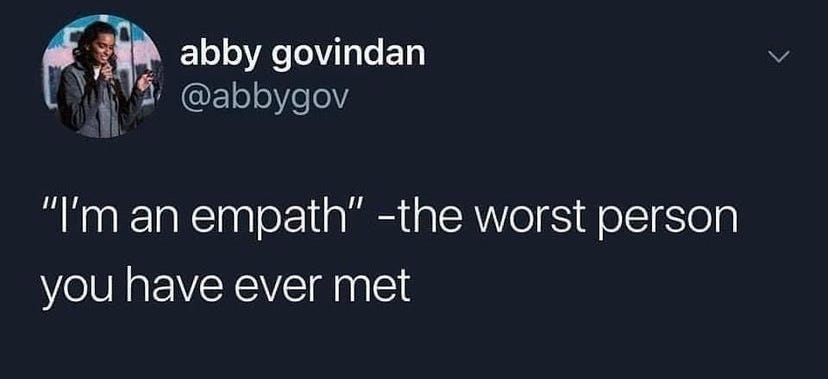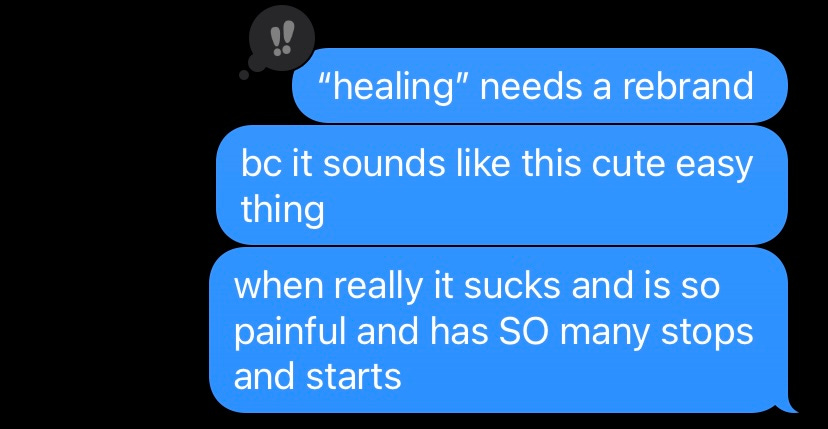Editor’s Note: Yes, yes, I’ve been gone for a while. A depressive episode and creative block will do that to a person. I’m hoping to be more consistent with these posts, and I appreciate your patience in the meantime.
A few weeks ago, I had dinner with two friends of mine. The conversation wandered to the topic of mental health and our issues with the rise of “therapy-speak” — a phenomenon in which psychological terms weave into the everyday lexicon, oftentimes thinning out the meaning of the terms themselves and, consequently, robbing those who could benefit from using these terms when describing their traumatic experiences.
“Like, I hate inner child,” one of them said, “When someone’s like ‘I’m healing my inner child.’ Shut up! It’s so annoying.”
“Agreed,” my other friend said.
And I laughed and nodded along, because ‘inner child’ has become one of those overused phrases like ‘love-bombing’ or ‘gaslighting’ that seem to have lost all meaning. Like any word you use over and over again, the repeated phrase has morphed into a jumbled mess of sounds that makes you question the validity of language. Whittled down until they’re smooth and dull, these words lose the power they once held, and instead become stand-ins for describing lesser experiences.
But as someone who has been trying to connect to her younger self, I wondered about the origin of the term: Where does the idea of the ‘inner child’ come from, and does it — like so many other terms — hold a now-overlooked gravitas that we can perhaps tease out in order to benefit our own methods of communication?
In reality, the idea of the inner child originated with Carl Jung, who developed the term in accordance with his archetypes and believed that “we…extend the individual analogy of the divine child to the life of mankind” (Sjöblom et. al, 2016). The inner child, Jung proposed, acts as a ubiquitous archetype within the self, ever-present and influential in one’s life.
The archetype includes “all the past hidden ages that have made up one’s life journey,” meaning that, in very visceral ways, we are every age we have ever been all at once; all our ages and past experiences live in us and continue to affect us as we grow older (Sjöblom et. al, 2016).
Before I go any further, I want to emphasize that I’m not a psychology major. I don’t have a Masters in anything psych-related, and if I recall correctly I got a 3 on my AP Psych exam (that’s passing, folks!). At most, I have a mild interest in Carl Jung. If you’re interested in learning more about these concepts, I recommend reading studies on the phenomenon of the inner child or on the rising popularity of therapy speak.
Everything that I write is just…how I feel about it all.
As I’ve done more research, however, I’ve found that I have several gripes with the ‘inner child’ concept specifically.
Because it’s true, the phrase I’m healing my inner child is commonly used by some of the most annoying people you’ve ever met — the blonde, white yoga instructor who wears shirts that read Nama-Stay In Bed, the friend who started therapy three weeks ago and now claims they’re an empath (no seriously, like, I totally am!), your aunt who fat-shamed you at a Christmas party when you were twelve. Irony of ironies.
Even in the therapy world, companies produce blogs on healing your inner child in just 7 steps, or maybe 8, or 10, depending on who you ask.
Part of my frustration comes from the fact that these posts — and the ways in which we’ve weakened these terms for the ease of everyday use — have skewed how we view healing.
In a capitalist, patriarchal country that places an emphasis on individualism, our beliefs about ‘healing’ have twisted into a competition, a fixed race, instead of an ongoing, ever-changing and often abrasive process. Our ideas, therefore, about “healing our inner child” have skewed — the process becomes about fixing ourselves rather than continuously meeting our younger selves with the love and compassion that we’ve always deserved.
As if any of us have ever been fixed beings. As frickin’ if!
So that’s Gripe #1. ‘Healing’ needs a rebrand.
Gripe #2 is more personal, so I may lose some of you. Hopefully I’ll keep some of you, too.
My personal gripe as I’ve been doing (bleh! boo!) inner child work (hiss!) comes from the burden of responsibility I have now, as an adult, to constantly soothe my younger self, to have all the answers, to know exactly what I’m doing. I think that feeling stems from the systemic pressure for healing work to exist within a vacuum, to be fixed rather than ongoing, which fuels my need to tell my past self It’ll be okay. I’ll be okay.
I mean, I’m an adult now, right? I should have this ‘inner child’ stuff solved by now.
The other night, I was meditating (I told you I would lose some of you! Stick with me, I have a point, I promise!) because I’ve felt really disconnected from myself lately. So, I’ve been trying. I’ve been trying to connect to my current self and my younger self, and as I sat in my bed watching a candle flicker on my nightstand, I wondered what it would feel like to connect with my future self, too.
And I got this image in my head where I saw every single version of myself — every age I was and the age I am and all the ages I will be — all lined up in a row, all looking at one another. And I realized that the inner child I am trying to ‘heal’ is, as Carl Jung claimed, actually ever-present. Turns out he has some good ideas.
This moment I had — of feeling not only a thread to my past, but a seamless tether throughout my life and into my future — was and is an eye-opening reminder that I am still and always will be the youngest I’ll ever be again. That this life, my life, isn’t separate from any version of myself — past, present, or future — but an ever-changing embodiment of those versions. And that, just like I’m doing for my younger self now, there are future versions of me looking back at this time in my life, telling me that I am not alone. Everything will be okay.
That I am, all at once, all the ages of my life, and doesn’t it make sense that I don’t have everything all figured out yet? Doesn’t that track, and can’t I give myself some grace?
When we overuse terms like ‘inner child work’, we devalue the importance of the practice. The significance of the inner child archetype, its myth, its awesome power, dwindles under the misinterpretations of human experiences, of what it means to be alive. Your inner child isn't a box you can check on a Good Mental Health Person form. Your inner child is you — always changing, always receiving, always vulnerable, always searching for love and compassion.
In many ways, the friends I went to dinner with were right: the watered-down definition of ‘inner child’ has become as flimsy and meaningless as so many other words lost to the erosion of time and capitalism. But I think it is crucial to remind ourselves of the fundamental significance of these practices — that the act itself of connecting to our inner child is a visceral, emotive, and often profound experience.
As always, I fear that my ramblings have come off as pretentious and a little too woo-woo-spiritual rather than sincere, but I do desperately believe in the importance of connecting to your younger and older self, if only for the simple reminder that you are not alone, and you never have been.
Talk soon,
Meg







